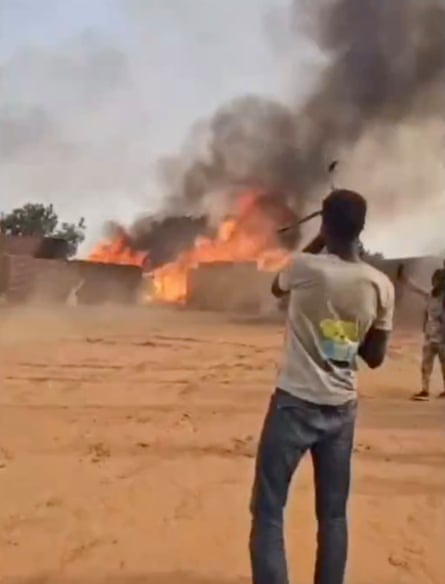The footage could become evidence for war crimes investigators, say observers, after the international criminal court put out a call for submissions of visual and audio evidence from Darfur last year.
“It’s someone condemning themselves. It’s not the same as a guilty plea but in some ways, it is a big piece of the puzzle that war crimes investigators have to put together,” said Alexa Koenig, co-creator of the Berkeley Protocol, designed to create an international standard for using social media to investigate war crimes.
More than 10,000 people – mostly from the African Masalit ethnic community – died in the Darfur city of El Geneina during two periods of intense fighting in 2023. A UN investigation later discovered a mass grave of dozens of Masalit civilians allegedly killed by the RSF.
A video shared by a pro-RSF account on X in June 2023 during the takeover of the city shows a fighter standing in front of the house of the sultan of Masalit saying “there are no more Masalit … Arabs only”.
Fighters have been posting footage of arson attacks on buildings and settlements on social media. Photograph: Courtesy of CIR
Another video shared from the city after it was seized by the RSF was filmed by someone walking through empty streets. He calls the population dogs and shows dead bodies lying in the middle of the street, saying they serve as roadblocks.
Other videos from the town of Ardamata, near El Geneina, in November 2023, show men in RSF uniforms rounding up groups of people and shouting slurs at them. In one video, a uniformed man holds the camera as if taking a selfie while fighters immediately next to him whip a detained man and strike him with a rifle.
The footage reveals some of what has been happening on the ground in parts of the region of Darfur in western Sudan, where journalists and activists have been unable to safely document violence.
“We’re in a situation where abusers are filming themselves, giving us evidence of what’s happening when we don’t have much information generally,” said Alessandro Accorsi, a senior analyst at the NGO Crisis Group.
“They can do that because they probably feel little fear of consequences and because the cost opportunity of inditement is far greater than the punishment.”
Anouk Theunissen, from CIR’s Sudan Witness project, said they had collected and verified thousands of open sourced footage so far to provide information and data for future efforts to hold perpetrators to account.
There is precedent for the use of perpetrator-filmed footage. In the 1990s, Serb paramilitaries known as the Scorpions filmed themselves executing Bosnian men and boys near Srebrenica, during massacres that have been recognised as genocide.
The footage was circulated on a limited number of videotapes, many of which were later destroyed, but some ended up in the hands of Serbian human rights lawyer Nataša Kandić after a tip-off that allowed her to obtain them and use them in war crimes tribunals.
More recently, footage from Tadamon, a neighbourhood in the Syrian capital Damascus, showing civilians being executed while standing in a pit, was leaked from files held on the laptop of a government military intelligence service. It has been used in attempts to prosecute under universal jurisdiction – a principle that allows war crimes to be prosecuted in countries other than where they occurred.
While Amjad Yousef, the military intelligence official shown shooting detainees, has continued operating from a military base near Damascus, a trial against an associate named as Ahmad H, who was identified in the videos by a witness, has been under way in Germany since May.
Experts say footage of atrocities sometimes circulates among a small group before being leaked, but on some occasions it is intentionally shared widely in order to intimidate potential future victims.
“They are doing it to show the people who they are,” said Adam Mousa Obama, from Darfur Victim Support. “They are proud of themselves and their abuses. They are sending a message that you cannot defeat us, we are very brave, we know how to fight.”






